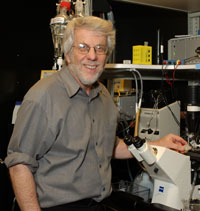
November 2009
Visionary
Training the Best Scientific Minds
By Allyson T. Collins, M.S.
NEI Science Writer/Editor

Sheldon Miller, Ph.D.
Scientific Director
Division of Intramural Research
National Eye Institute
Sheldon Miller, Ph.D., came to the NEI in 2002 as scientific director of the Division of Intramural Research. He oversees vision research projects and scientists who work on the National Institutes of Health (NIH) campus in Bethesda, Md. He also conducts his own research on the function and regulation of epithelia--tissues that serve and protect organs throughout the body. In particular, his studies involve the retinal pigment epithelium, a tissue in the back of the eye involved in many diseases that lead to significant vision loss and blindness.
In a recent interview, Miller talks about the NEI's new international research collaboration and his passion for attracting and training the best scientific minds he can find.
A year and a half ago, the NEI initiated the concept for the Indo-U.S. Research Career Transition Award Program. How will this program work?
Through this initiative, the NIH will collaborate with the Department of Biotechnology of the Ministry of Science and Technology in India. We hope that the program will draw young scholars from India--those who have recently completed their doctoral degree--to the NIH for additional training. When they finish, they will be well-positioned for a research or faculty position at an institution in India. The NEI is administratively leading this program right now. In addition to the NEI, the collaboration includes three other Institutes, but it will eventually include all Institutes. We will begin recruiting participants in the coming months.
"High-quality scientific training provides the foundation for high-impact scientific advances," Miller says.How did the idea for this program come about?
I realized early on in my time at the NEI that we had many research fellows coming from overseas, and many of them were not returning to their home countries after they completed their training. So several years ago, I went to India, China and Singapore to meet with government officials and scientists. I proposed a collaborative international scholars program that would identify highly qualified, potential scientific leaders, bring them to the NIH, and guarantee that they would return home at the end of their training program. They could also apply for special NIH funding to support their research back in their home countries.
Why is it so important that the fellows return to their native countries?
There are more than two billion people in India and China, which is a large pool from which to draw potential biomedical scientists. This program will help countries like India build strong research infrastructures to support these scientists and will help maximize the number of strong research groups worldwide. For this reason, I believe it's in the best interest of global biomedical research for us to train the very best overseas scholars, and encourage them to return home and continue collaborating with U.S. researchers. In this time of reduced resources, some people question the need for such a program, but we think that in the long term it will be very valuable in the global effort to combat disease. And, of course, this program also directly supports U.S. biomedical research needs.
In what way?
When we work with other countries like India or China, we as researchers have access to specialized disease populations that we don't see here in the U.S. There are larger populations that have different eye conditions or more concentrated populations with the same conditions, making them easier to study. Also, it's best in science to have ties with as many researchers as possible. That's how individual projects and science in general move forward--you talk to other people who are doing similar experiments.
You keep mentioning China as well as India. Do you have plans for a similar program there?
Yes, India is the pilot program, but if the program is successful it will apply to other countries. And though we're going to start with a relatively small number of fellows from India, it takes just a few well-trained, talented researchers to make a significant impact.
So is the most important aspect of this collaboration the training or the new scientific breakthroughs that may result?
Both. High-quality scientific training provides the foundation for high-impact scientific advances.
Why are you focused on drawing great researchers from abroad? Why not train students from the U.S.?
The NEI and other Institutes do have significant recruitment programs in the U.S., and we receive excellent students through these. However, American students have a range of other career opportunities in law, business, finance and medicine that compete with the lure of biomedical science. Plus, it's a simple numbers game. China and India make up nearly 50 percent of the world's population, so a large number of these students seek training in the U.S. The bottom line, however, is that we want the best scientific minds, no matter where they come from.

